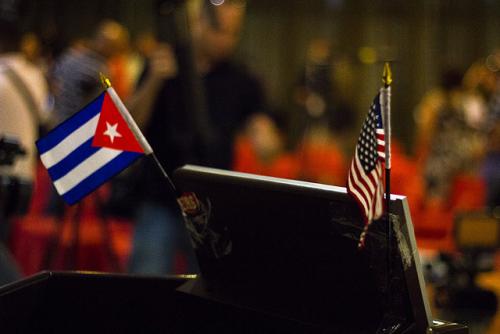What lies ahead for Cuba and Latin America in 2018
- Opinión

A good friend of mine who has been living in the United States for many years, whom I consider an excellent analyst of international political issues, tells me that former President James Carter recognized, just a few months ago, that it was his mistake not to have completed the process of normalization of relations with Cuba during his term in the White House.
The subject came up in light of the indication that, in his view, for more than two months, Trump’s destructive drive against relations with Cuba has entered a new phase. The momentum seems to have lost steam in the sense that there have been no new hostile actions. The farce of the “sonic attacks” was officially frozen, and the bilateral meetings and specific negotiations that began before Trump are being resumed.
According to my friend, “it is as if the course towards the collision was being reconsidered, giving way to a kind of temporary truce, or towards a certain arrangement or new modus vivendi.” This is not the first time an approach of this type has turned up in the policy options that appear at the level of the executive branch by way of proposals.
In 1979, Robert Pastor, assistant and very close advisor to Zbigniew Brzezinski, himself advisor to US President Lyndon Johnson between 1966 and 1968 —when describing several proposals on Cuba— introduced the notion of “Cool but Communicative”. This meant that Washington should maintain communication channels with Havana, but at the same time, should be tightening a siege around Cuba’s neck.
Could this apparent temporary truce be a new version of the “Cool but Communicative” style or—considering the different context that sustains Cuba’s international position, as well as the domestic support in the United States for normalization of ties with the Island—a move towards a low profile modus vivendi, that might bring stability?
Of course, the siege that Pastor talked about then was set in a very different context from today’s. The governments of Canada and of all Latin America are aligned in favor of the normalization of trade and cooperation with Cuba.
The Prime Minister of Japan, Shinzo Abe, visited Cuba and promotes relations with his country. South Korea has become an important commercial partner of Cuba and their positions are approaching normalization.
The European Union advances in the Political Dialogue and Cooperation Agreement with Cuba, after three visits to Havana by Federica Mogherini, the High Foreign Policy Representative and Vice President of the European Union.
Just a few days ago, Trump met with the Prime Minister of Norway, a country that has cooperated closely with Cuba for years in the peace process in Colombia. Without these players on the oppressor´s side, there is no possible siege; the position of all of them contradicts the course announced by Trump in Miami last June 16.
I do not share the forecast that Trump’s policy towards Cuba includes a cooling and temporary truce in its aggressiveness. That is not what becomes apparent, among many other things, after the announcement of the setting up of a new Internet Task Force aimed at subverting Cuba’s internal order. This assumes the continuity of failed Cold War policies and the blockade as part of the doctrine of Unconventional Warfare that have proven inoperative against the concept of All Peoples’ War on which the Island bases its defense readiness.
On the other hand, I do fully agree as to how influential a majority opinion can be in favor of the normalization when it is supported by important pressure groups and American economic interests agreeable to a low profile modus Vivendi. This option runs contrary to the one Marco Rubio has been working for with his spectacular farce of sonic attacks and inconsequential senatorial hearings against Cuba.
The upcoming electoral victory in socialist Cuba will bring continuity to the revolutionary process on the Island. It will stimulate peoples throughout Latin America to continue their struggle for self-determination against the designs of the local oligarchies and the imperialist hegemony of the United States.
The presidential victory of the Chilean right wing led by Santiago Piñera could not silence a remarkable rise of the center-left forces represented by the novel example of the Frente Amplio (Broad Front).
Additional factors will include: the return of Lula and the Workers’ Party in Brazil, MORENA with López Obrador in Mexico, the almost certain victory of Maduro and the United Socialist Party in Venezuela, in the face of an atomized opposition backed by all the resources of the US empire; the undoubted victory of Evo in Bolivia. Finally, Macri’s crisis in Argentina, the uncertain outcome in Colombia and the return of the left in Paraguay, are the most commented scenarios of in Latin America’s patriotic struggle in 2018.
January 25, 2018
- Manuel E. Yepe
A CubaNews translation edited by Walter Lippmann. http://walterlippmann.com/what-lies-ahead-in-2018/
Del mismo autor
- ¿Por qué la sostenida popularidad de Trump? 20/07/2020
- Ya no es la economía, estúpido, es el virus 15/07/2020
- De qué no será capaz Trump para reelegirse 02/06/2020
- The Capitalist Crisis is Worse than Covid-19 26/05/2020
- Refutación del fundamentalismo religioso 19/05/2020
- Precedents in Cuba of “Operation Gideon” 16/05/2020
- Precedentes en Cuba de la Operación Gedeón 14/05/2020
- Los grandes perdedores del Super Bowl 18/02/2020
- El papel del miedo en las elecciones de EEUU 11/02/2020
- Impacto de Trump en la juventud de EEUU 24/01/2020
